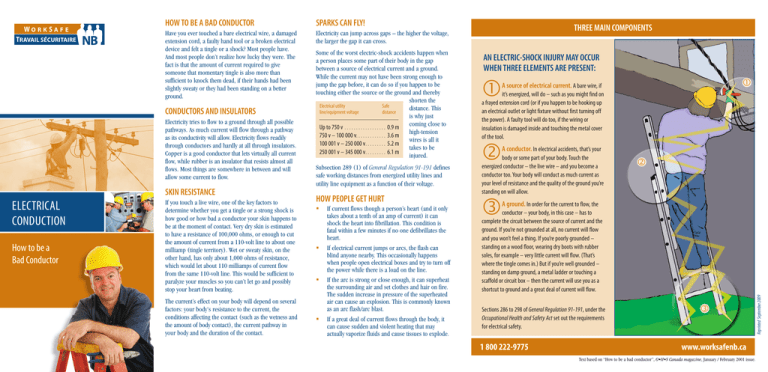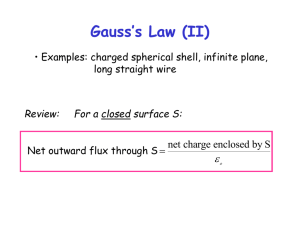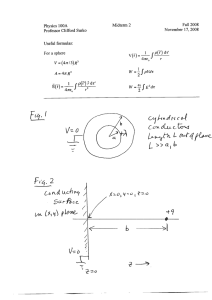ELECTRICAL CONDUCTION
advertisement

SPARKS CAN FLY! Have you ever touched a bare electrical wire, a damaged extension cord, a faulty hand tool or a broken electrical device and felt a tingle or a shock? Most people have. And most people don’t realize how lucky they were. The fact is that the amount of current required to give someone that momentary tingle is also more than sufficient to knock them dead, if their hands had been slightly sweaty or they had been standing on a better ground. Electricity can jump across gaps – the higher the voltage, the larger the gap it can cross. CONDUCTORS AND INSULATORS Electricity tries to flow to a ground through all possible pathways. As much current will flow through a pathway as its conductivity will allow. Electricity flows readily through conductors and hardly at all through insulators. Copper is a good conductor that lets virtually all current flow, while rubber is an insulator that resists almost all flows. Most things are somewhere in between and will allow some current to flow. SKIN RESISTANCE ELECTRICAL CONDUCTION How to be a Bad Conductor If you touch a live wire, one of the key factors to determine whether you get a tingle or a strong shock is how good or how bad a conductor your skin happens to be at the moment of contact. Very dry skin is estimated to have a resistance of 100,000 ohms, or enough to cut the amount of current from a 110-volt line to about one milliamp (tingle territory). Wet or sweaty skin, on the other hand, has only about 1,000 ohms of resistance, which would let about 110 milliamps of current flow from the same 110-volt line. This would be sufficient to paralyze your muscles so you can’t let go and possibly stop your heart from beating. The current’s effect on your body will depend on several factors: your body's resistance to the current, the conditions affecting the contact (such as the wetness and the amount of body contact), the current pathway in your body and the duration of the contact. Some of the worst electric-shock accidents happen when a person places some part of their body in the gap between a source of electrical current and a ground. While the current may not have been strong enough to jump the gap before, it can do so if you happen to be touching either the source or the ground and thereby shorten the Safe Electrical utility distance. This distance line/equipment voltage is why just coming close to Up to 750 v������������������ 0.9 m high-tension 750 v – 100 000 v������������ 3.6 m wires is all it 100 001 v – 250 000 v��������� 5.2 m takes to be 250 001 v – 345 000 v��������� 6.1 m injured. Subsection 289 (1) of General Regulation 91-191 defines safe working distances from energized utility lines and utility line equipment as a function of their voltage. HOW PEOPLE GET HURT I f current flows though a person’s heart (and it only takes about a tenth of an amp of current) it can shock the heart into fibrillation. This condition is fatal within a few minutes if no one defibrillates the heart. If electrical current jumps or arcs, the flash can blind anyone nearby. This occasionally happens when people open electrical boxes and try to turn off the power while there is a load on the line. If the arc is strong or close enough, it can superheat the surrounding air and set clothes and hair on fire. The sudden increase in pressure of the superheated air can cause an explosion. This is commonly known as an arc flash/arc blast. If a great deal of current flows through the body, it can cause sudden and violent heating that may actually vaporize fluids and cause tissues to explode. THREE MAIN COMPONENTS AN ELECTRIC-SHOCK INJURY MAY OCCUR WHEN THREE ELEMENTS ARE PRESENT: A source of electrical current. A bare wire, if it’s energized, will do – such as you might find on a frayed extension cord (or if you happen to be hooking up an electrical outlet or light fixture without first turning off the power). A faulty tool will do too, if the wiring or insulation is damaged inside and touching the metal cover of the tool. A conductor. In electrical accidents, that’s your body or some part of your body. Touch the energized conductor – the live wire – and you become a conductor too. Your body will conduct as much current as your level of resistance and the quality of the ground you’re standing on will allow. A ground. In order for the current to flow, the conductor – your body, in this case – has to complete the circuit between the source of current and the ground. If you’re not grounded at all, no current will flow and you won’t feel a thing. If you’re poorly grounded – standing on a wood floor, wearing dry boots with rubber soles, for example – very little current will flow. (That’s where the tingle comes in.) But if you’re well grounded – standing on damp ground, a metal ladder or touching a scaffold or circuit box – then the current will use you as a shortcut to ground and a great deal of current will flow. Sections 286 to 298 of General Regulation 91-191, under the Occupational Health and Safety Act set out the requirements for electrical safety. 1 800 222-9775 www.worksafenb.ca Text based on “How to be a bad conductor”, O•H•S Canada magazine, January / February 2001 issue. Reprinted September 2009 HOW TO BE A BAD CONDUCTOR




